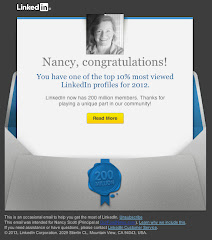A few days ago I blogged about the stupidity of “auto-communication” with social media “friends.” The evidence builds that this is even more stupid than I thought.
A June 22 Time magazine article cited some interesting research about the dismal effect email is having on human relationships, both in the office and outside – namely, that interpersonal trust relies to some extent on face-to-face communication that's often missing in our lives today. Who knew?
Meanwhile, Time says that both current and prospective friendships are being electronically processed, too.
There’s more. Do you have people with whom you discuss important matters? Before 1985, you’d likely have said yes. Now, you just retreat into a corner with your iPhone. According to a Duke University study completed in 2006, the percent of Americans today who say “I have no one” has tripled in the last 25 years. On top of that, Americans report one-third fewer friends and confidants generally. Let's face it; we’re lonelier .. but we still have Facebook, right? Uhhhhhh, sure. We have lots of Facebook friends (hundreds!), except apparently we don’t care about them, they don't care about us and, well, nobody cares.
A widely reported University of Michigan study noted that college students today have 40% less empathy than their counterparts of the 80s and 90s. The study offered no explanation for the indifference, but Sara Konrath, a researcher at the university’s Institute for Social Research, points to the fact that GenYs (born from 1980 to about Y2K) tend to communicate more through social media than face-to-face. Susan Maple who blogged about this for the parenting site Strollerderby thought this research study might simply be one more in a long line of attacks against GenY. Hold on there..
I’m not going to say GenY doesn’t have a problem, but I am most definitely not going to attack the kids who were born between the early 80s and Y2K. I have a host of observations on what was afoot during this period. It wasn’t very good and it wasn’t their doing. They were children.
What exactly happened during GenYs formative years. For starters, how about this?
• shockingly little face-time with the family unit;
• disappearing connections with extended family and mostly zero inter-generational relationships on a regular basis;
• highly structured artistic, learning, and sporting activities, with a growing emphasis by the parents on the “goal” to be achieved from, rather than the inherent pleasure of, the activity;
• a near total lack of free-form, creative play opportunities and almost no chance to play unsupervised with other kids where genuine peer-to-peer relationships could emerge;
• an American educational system hell bent on “message over matter,” like telling kids how very “special” they were, even when nobody believed it -- not the teachers, or the parents, or the kids.
• a frantic drive to achievement and winning substituting for any chance to learn independently about vital life skills like personal insight and self-awareness;
• an atmosphere of near-hysterical “fear” of strangers;
• television sets serving as the nation’s child care provider: always available, but cold, flickering, indifferent (just like computer screens);
• handing much of the country's very significant purchasing power of this era to children, who were given a consulting role in every buying decision from automobiles to housing.
So there it is. There's lots to be said about why this all happened, but that's another story. It happened -- especially to the striving middle class of GenY users that the studies are writing about. Clearly, this has not played out well. No wonder. As my pediatrician was fond of saying, “Being Master of the Universe is too a big a job for a child.”
And now I’ll go check-in with my Facebook friends. CYa.
-- scrubbed by MarketingBrillo
